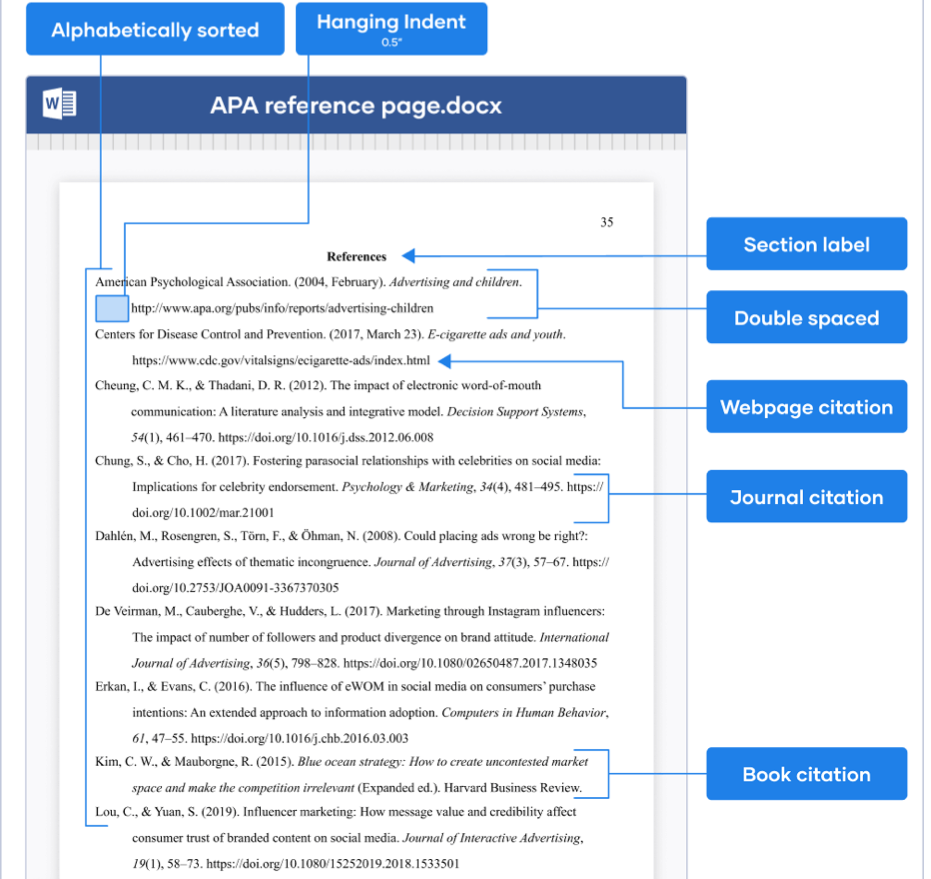
|
Getting your Trinity Audio player ready...
|
A reference page is an essential component of an academic paper or research document that serves as a repository for all the sources cited in the paper’s in-text citations. It is a separate page at the end of a research paper that provides detailed information regarding cited sources.
American Psychological Association (APA) reference page:
As the name suggests, an “APA reference page” or “APA works cited page” lists all the sources cited or referenced within the text using the APA citation style. It provides detailed bibliographic information about each source, including the author(s)’ names, publication date, title of the work, and publication information.
Creating a reference page in APA format
Creating a reference page in APA format involves organizing the sources and following a specific format for each entry depending on the source type. The detailed steps are as follows:
• Start the reference list on a new page after the body of the text but before the tables and figures.
• The title “References” should be centred at the top of the new page, in bold.
• List the references in alphabetical order by the author’s last name. If there is no author, use the title of the article instead.
• Use a hanging indent for each reference, where the first line of the reference is flush left, and the subsequent lines are indented (i.e. 0.5 inches).
• Format each reference according to the source type (e.g., book, journal article, website).
o Author name: Author names are presented as last name and initials of the first name followed by a period.
o Publication Date: Year of publication, enclosed in parentheses followed by a period.
o Title: Title of the work is presented in sentence case, followed by a period. For books and journal articles, the title is italicized. For articles or chapters in edited books, sentence case is used.
o Source Information: Provide information about where the work was published. This could include the name of the journal, book title (for chapters in edited books), or website, followed by a period. For journal articles, include volume and issue numbers, if applicable. Depending on the source type, you may need to include information such as page numbers for articles or chapters in books.
APA Reference Page Example
A typical reference page in APA format looks like this:

Image courtesy: https://www.scribbr.com/apa-style/apa-reference-page/
What to include and exclude in an APA style reference page?
In an APA format reference page, you should include all the sources that you cited in your paper.
However, sources that were referred to support your arguments or claims in the paper but not directly cited within the main text are typically not included in the reference list. Some examples of sources that are not included on the reference page include:
• General Information: Well-known facts or widely accepted theories that are considered common knowledge and does not require citation.
• Non-retrievable sources: Sources that cannot be accessed or verified by readers, such as private documents or oral presentations that were not documented.
• Personal communications: Personal communications such as emails, interviews, or conversations that were not formally published or made publicly available.
However, if you are using a bibliography instead of a reference page, some of these sources may be included in the bibliography to provide a comprehensive list of all materials consulted during the research process.
Bibliography: Difference between bibliography, annotated bibliography, reference page, and works cited.
Although, in a broader sense the terms “bibliography”, “annotated bibliography”, “references”, and “Works cited” mean the same and are used interchangeably, there are subtle differences in the content of each of these and they serve slightly different purposes depending on the citation style being used.
To understand the differences between these terms, let us first see the definitions of each of these.
Bibliography: A bibliography is a comprehensive overview of the literature and resources consulted during the research process, regardless of whether they were cited directly in the paper or not.
Annotated Bibliography: An annotated bibliography goes beyond a simple list of sources by including annotations or concise summaries and evaluations of each source. These annotations provide additional information about the methodology, findings, and relevance to the research project and provide the readers with more context and insight into the sources’ content.
Reference list: A reference list includes all the sources that you specifically cited or referenced in your paper. In other words, each source listed on the reference list corresponds to an in-text citation within the body of the paper.
Works Cited: Similar to “reference list” a “works cited list” includes only the sources that were directly cited or referenced within the paper and is commonly used in the context of the Modern Language Association (MLA) citation style.
From the above definitions, we can clearly differentiate that “reference list” and “works cited” refer to specific lists of sources that are cited in the main text, while “bibliography” provides a more comprehensive outlook of the sources regardless of whether they are cited directly in the paper. An “annotated bibliography” goes beyond a “bibliography” by including annotations or brief summaries about each source.
Click here to know more about our services: https://www.editage.us/services/research-paper-manuscript-formatting-services









Leave a Reply